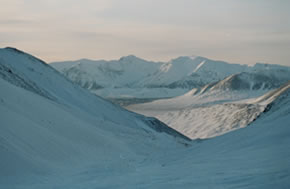Arctic Survival – Condensation and Vapour Barriers
Vapour is continually released from our bodies. In moderate temperatures this moisture goes unnoticed because it remains in a gaseous state and dissipates.
In cold temperatures, however, moisture released from our bodies becomes a serious issue. Due to the fact that more clothing is worn, there is less air circulation near the skin, and dissipation is slower. Additionally, cold air is unable to hold as much moisture, and as the warm, moisture-laden air nears the surface and cools, the vapour will condense in the fabric. As moisture builds up in your clothing, the insulating ability is compromised, potentially creating a dangerous situation.
For short one or two-day excursions condensation is an issue that can be dealt with easily by carrying a change of clothing. For long periods in the cold, however, it is a serious matter that should be considered carefully.
There are three ways to combat moisture buildup; using very breathable clothing, keeping cardiovascular activity low (slow down on the hills), and using vapour barriers. A vapour barrier works by creating an impervious layer between your skin and your outer insulating fabrics. They are usually made from thin pliable plastic. Often people shun vapour barriers because they are not comfortable and are clammy. In the long term, however, vapour barriers do enhance comfort and safety.
Vapour barriers are not essential for your entire body; as paying heed to breathability can reduce condensation to a safe level. Feet are usually a problem area, since the thicker outer materials of footwear limit air flow. Vapour barrier socks can be purchased from specialized outdoor stores and should be used on extended cold-weather excursions. Thin polypropylene socks should be worn next to the skin with the vapour barriers worn over top. Your insulating layers (wool socks, etc) are then placed over the vapour barrier. With this arrangement, your feet will remain toasty warm no matter how long you’re in the field.
Another important area to use a vapour barrier is in your sleeping bag. A huge amount of moisture is released while sleeping, and within a few days moisture buildup can seriously compromise the insulating ability of the bag. Down fill is especially affected by moisture.
Sleeping bag vapour barriers are akin to a garbage bag shaped to a human body. You slide into the bag before entering the sleeping bag. Plastic against the skin is a little uncomfortable. Additionally, the moisture buildup within the plastic bag can create small puddles of water, so wet exit in the morning into -40 or so degree temperatures is an excruciating process. Despite the discomfort, vapour barriers in sleeping bags are essential for long-term survival in the cold.
Due to the high moisture content within the vapour barrier, minimal or no clothing should be worn; otherwise it will be wet in the morning.

